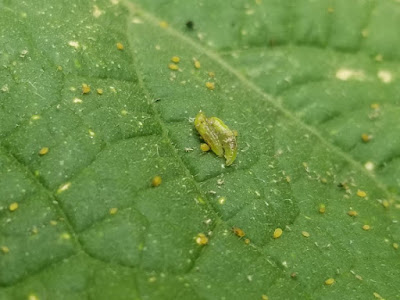My very favorite time to grow carrots is from the fall to the spring. Unfortunately, due to the dry weather in the fall and the squirrels in the winter, I rarely get any carrots at all. So here is a picture of a few carrots I harvested last spring.
My very favorite time to grow carrots is from the fall to the spring. Unfortunately, due to the dry weather in the fall and the squirrels in the winter, I rarely get any carrots at all. So here is a picture of a few carrots I harvested last spring.
With all the posts about "good" and "bad" bugs, I really wanted to mention something. Just as plant roots suffer without healthy bacteria (those of you with clorinated pools near your garden know what I am talking about) I believe that my garden suffers without some amount of insect life. Specifically, what I am referring to is the lowly aphid.
Though a gardener may prefer to have no aphids at all, I believe that having a mild number of aphids on my plants is really good. Why? Because aphids are the foundation insect for many of the beneficial insects I appreciate in my garden. Ladybugs, lace wings, hoverflies, parasitic wasps, other wasps, assassin bugs, mantids, spiders, etc.
 |
| Syrphid Fly larvae eat aphids |
 |
| Ladybird beetle larvae love aphids too |
While I do work to reduce aphid populations before they really damage any one plant, I believe that using an Integrated Pest Management approach helps to keep garden pests in perspective. Instead of fighting my gardening problems, I much prefer to let nature to take care of some of my pests (excluding cucumber beetles) before I really need to.
Found this in a regional nature paper in Solano County, California. Quite fun and true. Cucurbit growers beware!!!
Many seed catalogs and hardware stores will soon begin selling beneficial insects. Before deciding to purchase beneficial insects to import into the garden environment, it may be wise to observe what beneficial insects already exist in the area. When I used to live in Tucson, I would see hardware stores sell a whole lot of ladybugs and Chinese mantid oothecas (or praying mantis egg cases). Though it can be temporarily fun and beneficial to introduce insects to the garden, it often does not always pay off in the long-run. Ladybugs are often sold in the spring, when in Tucson, they are only willing to stay around in the cool season - meaning that the ladybugs will make use of their wings to leave the garden as soon as possible.
Aphidius colemani mummy (wasp parasite)
Likewise in Tucson, though Chinese mantids are larger than other mantids, they don't stand a chance in the Southwest compared to the Arizona or Mediterranean mantids that have already established themselves in the area. In contrast, Lacewings and parasitic wasps are very plentiful throughout the year in Tucson, so if I didn't have them present, but had a very large garden that could support their population, I could order them from a company that sells beneficial insects.
Possibly Mediterranean ootheca found around Fairfield, CA
One alternative purchasing insects that don't do well in an area could be to attract local beneficial insects by growing small flowering plants or letting our carrots or dill bolt and flower (attracting Lacewings, parasitic wasps and ladybugs). Various flowering bushes/shrubs also attract beneficials (mantids love to eat flying insects that visit the flowers, then hide among and lay eggs on the branches).
 |
| Local mantid ootheca (egg case) Fairfield, CA |
Providing an ideal environment for preferred insects will ensure they are welcome to the garden and encourages them to be around when they are needed most.
Over the winter between 2020 and 2021 I conducted a winter potato experiment. I found that Yukon Gold potatoes could be grown in Zone 9b over the winter, howbeit they don’t enjoy it much. That being said they did a lot better than I would have thought. The main concern that would take place is that the health of the foliage would decline over January and February. This is likely because of the minimal amount of light at that time of year.
For anyone who resides in a moderate climate where the yearly low hovers around freezing (between 30 and 32), I decided to try growing potatoes over the winter of 2020. I'm in Northern California Bay Area 9b. I began with organically-grown disease-free potatoes. For context, I planted into 3 different plots in different locations. I mainly grew Yukon Gold. So this is what I learned:
1: Potatoes can grow over the mild winter.
2: As soon as they are damaged by a light frost, the above-ground growth will stop, but the below ground growth will continue. On a related note, once frost damage has occurred, the potato tubers do not send out additional growth.
3: Squirrels leave the potatoes alone! (=
4: If you have a sheltered area with lots of radiant heat in the evenings, you may be able to grow potatoes without any concerns. Though a few potato plants in my raised bed garden received a little damage, the majority are still growing. (The other two plots did freeze, but not a hard frost).
5: As a summer gardener, I plan to start my next potatoes in September/October instead of November/December.
I hope this helps those of you who live in areas where you would like to grow potatoes, but have summers that are too hot to grow them.